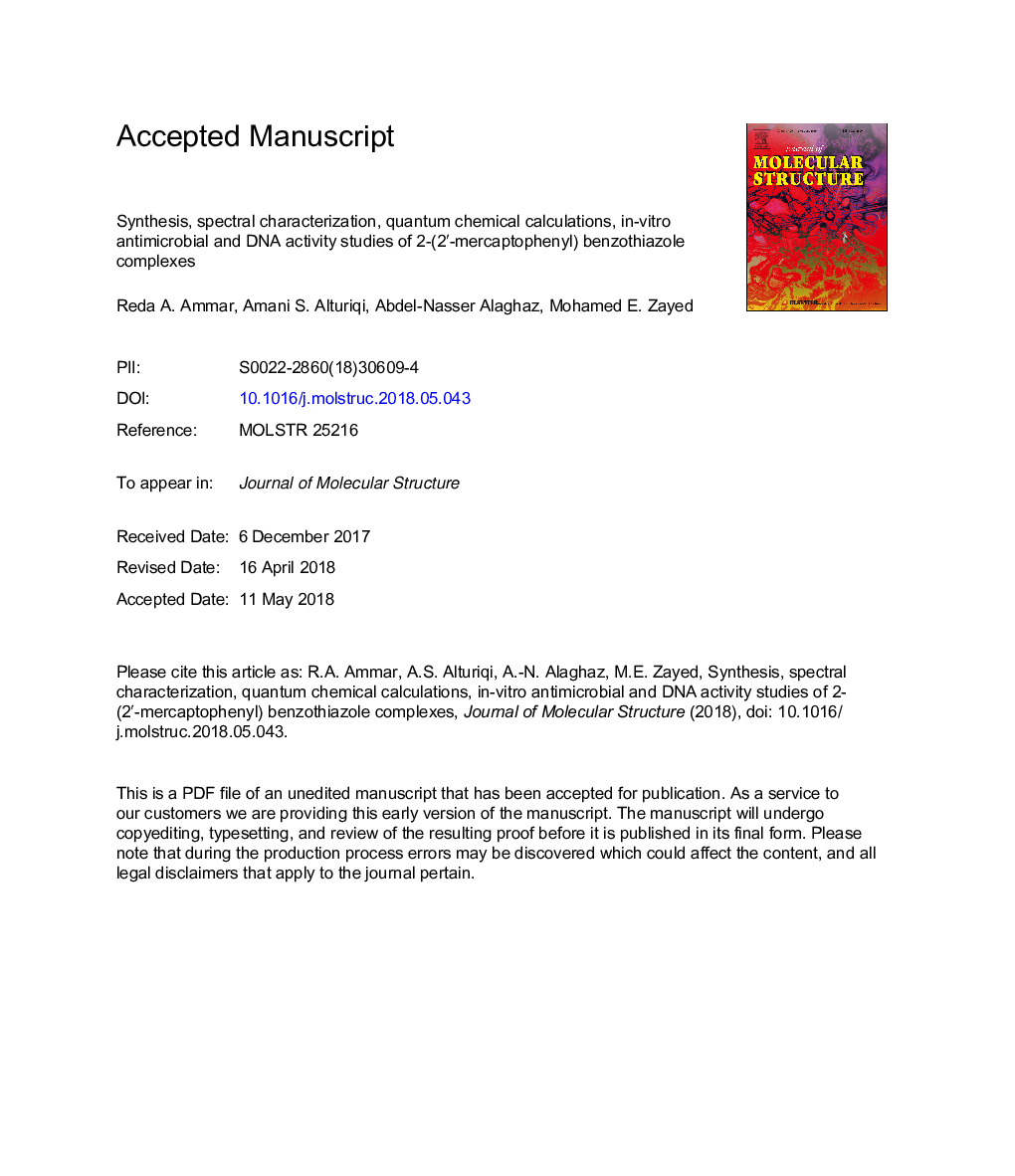| کد مقاله | کد نشریه | سال انتشار | مقاله انگلیسی | نسخه تمام متن |
|---|---|---|---|---|
| 7807024 | 1501649 | 2018 | 31 صفحه PDF | دانلود رایگان |
عنوان انگلیسی مقاله ISI
Synthesis, spectral characterization, quantum chemical calculations, in-vitro antimicrobial and DNA activity studies of 2-(2â²-mercaptophenyl) benzothiazole complexes
دانلود مقاله + سفارش ترجمه
دانلود مقاله ISI انگلیسی
رایگان برای ایرانیان
کلمات کلیدی
موضوعات مرتبط
مهندسی و علوم پایه
شیمی
شیمی آلی
پیش نمایش صفحه اول مقاله

چکیده انگلیسی
New ligand (HMPBT) ligand is prepared via condensation of 2-mercaptoaniline and 2-mercaptobenzoic acid in 1:1 ratio. Metal complexes are prepared and characterized by different physical techniques (IR, UV/Vis., 1H NMR, 13CNMR, TGA, DTA, DSC, XRD, magnetic moment and electrical conductance measurements). From the elemental analyses data, the complexes were proposed to have the general formulae [M(MPBT)2] (where Mâ¯=â¯Co(II), Ni(II), Cu(II) and Zn(II) and MPBTâ¯=â¯Ligand. The molar conductance data reveal that all the metal chelates were non-electrolytes. Infrared spectra of the complexes indicate deprotonation and coordination of the thiol SH. It also confirms that nitrogen atom of the benzothiazole group contribute to the complexation. Electronic spectra and magnetic susceptibility measurements as well as quantum chemical calculations reveal square planar geometry for Cu(II) and Ni(II) complexes and tetrahedral geometry for Co(II) and Zn(II) complexes. The activation of thermodynamic parameters are calculated using Coast-Redfern (CR), Horowitz-Metzger (HM), and Piloyan-Novikova (PN). The geometries of the complexes are confirmed using DFT method from DMOL3 calculations and ligand field parameters. The investigated ligand and metal complexes were screened for their in-vitro antimicrobial activities against different types of fungal and bacterial strains. The resulting data assert on the inspected compounds as a highly promising bactericides and fungicides. The binding activities of zinc (II) complex with CT-DNA was investigated using absorption titration, fluorescence spectroscopy and cyclic voltammetry measurements in a Tris-HCl buffer system at pH 7.0. In addition to these methods, gel electrophoresis and viscosity measurements were also carried out to determine DNA-binding activities with zinc (II) complex in a buffer solution. The results indicated that zinc (II) complex interacts strongly with CT-DNA through the intercalative binding mode.
ناشر
Database: Elsevier - ScienceDirect (ساینس دایرکت)
Journal: Journal of Molecular Structure - Volume 1168, 15 September 2018, Pages 250-263
Journal: Journal of Molecular Structure - Volume 1168, 15 September 2018, Pages 250-263
نویسندگان
Reda A. Ammar, Amani S. Alturiqi, Abdel-Nasser M.A. Alaghaz, Mohamed E. Zayed,